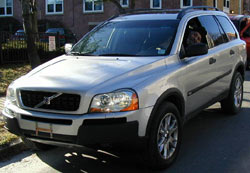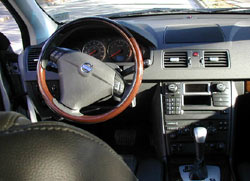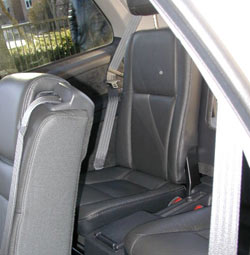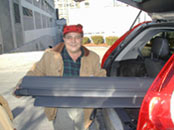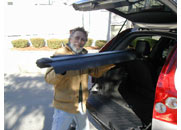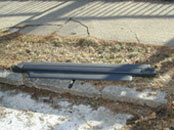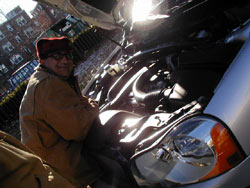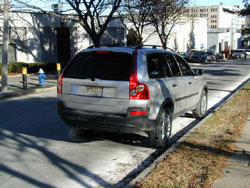Volvo XC-90 (2003)
 | ||
 |  |  |
| ||||||
| Good: reasonably safe, good handling, nice looking Bad: cramped third row seats, challenge to service |  |  |  |  | ||
Volvo used to have one car. The Volvo 240. Boxy but good. Remember that? Oh, sure, they had some variations: boxy but good wagon, boxy but good sedan, boxy but good with a six-cylinder engine. But Volvos were safe, durable boxes. Well, times have changed. Over the last decade, Volvos have been getting "sportier," more "stylish," and now, with a foray into SUV-dom, even "trendy"! Of course, despite this effort to broaden its appeal with more powerful engines and rounded sheet metal, Volvo is still best known for making safe cars. And that's still the basis on which Volvo makes most of its vehicle sales. So, as you might imagine, they went to great lengths to make a Volvo SUV that could reasonably be called safe-- with a straight face. After building a reputation for safety over half a century, they didn't want it to roll down the embankment with one tippy SUV. Rollovers are the biggest SUV safety hazards these days-at least the biggest hazard to SUVs themselves. So Volvo's big contribution to SUV safety on the XC-90 is their new electronic Roll Stability Control system. It's basically a gyroscopic sensing unit that senses roll, applies individual brakes to control the vehicle's handling, and prevents this SUV from ever rolling over. Well, at least prevents it from rolling over as a result of your driving. If you get hit in the side by a school bus, all bets are off. But it's still an impressive leap forward in safety technology. And Volvo's owner, Ford, will almost certainly use it on other SUVs eventually.
We didn't push the XC-90 all the way to its limits (car companies get awfully annoyed when you overshoot by just a little bit on those "limit" tests), so we can't say for certain that the Roll Stability Control works as described. But we've read reports of other tests in which it was pushed to the limit. And the consensus is that it does work. So, good work, Volvo. What will this technology cost you? Well, since it comes in a modern Volvo, with leather seats and a bunch of other gizmos and gadgets, it ain't cheap. The cars.com target prices range from $32,900 for the base XC-90 with two wheel drive and the smaller engine to $42,900 for the full duded up, T6 all-wheel drive, which is what we drove. | |||||
 | There's no question that the XC-90 is a nice vehicle. You get a sense of quality as soon as you get into it. And as soon as you start driving it, you realize it's an awfully good-handling SUV --- stable and flat in the corners. But there was also a strange "disconnect" from the road in XC-90. And that's due to a steering feel that is extremely light --way too light for our tastes. There's simply too much power in the XC-90's power steering. And as a result, you never really get a feel for exactly what the front wheels are doing. This may have been intentional- an attempt to appeal to non-SUV drivers and make the XC-90 seem as car-like as possible. But we found it disconcerting, and we were never able to feel fully confident while driving the XC-90. We know Volvo can make vehicles with good road feel (the XC-70 wagon, for example, has a heavier, more realistic power steering boost), and we hope Volvo decides to back off on the boost in future XC-90s. More road feel would be quite welcome here. That aside, objectively, the handling of the XC-90 can only be called very good. Certainly better than many SUVs on the market. Plus, the ride is smooth. At low speeds around town, the suspension really absorbs potholes and other bumps. Soccer moms and entry-level-luxury-car-drivers will find the XC-90 well suited to their tastes.
The engine in our T6 test car had plenty of power, certainly more than enough for daily driving around town. We did notice that it was a little bit louder than we would have expected, but it moved the XC-90 instantaneously and smoothly any time you stepped on the gas pedal. There are two engines options for the XC-90: a 2.5-liter, five-cylinder turbo and a 2.9-liter, six-cylinder twin turbo (the T6) we tested. We're a little concerned that the 2.5 cylinder engine is on the small side for the XC-90's 4,500 pounds. That's the same engine that seems just adequate in the much lighter XC-70 station wagon. And while turbo durability is much better than it used to be, you'll be using a lot of turbo boost with the smaller engine, and eventually, it may go. If that happens, it's going to cost you a small fortune. Consider yourself warned-especially if you have a "heavy foot." So we lean toward the larger, T6 engine, especially if you opt for all-wheel-drive, which adds additional weight to the drive train. Even with a six-cylinder engine, the XC-90's gas mileage isn't great; 15 around town and 20 on the highway. The five cylinder does a little better, 18 and 24.. The XC-90 T6 has a four-speed, automatic transmission, which is increasingly unusual in high-end cars (strangely, the smaller engine gets a five speed, because there was more room).They're all going to--or have gone to--five or more speed transmissions. Volvo's "geartronic" transmission has an automatic and manual mode, which is very elegantly designed. It's one of the best "manu-matics" we've seen. | ||||
  |
The inside of the XC-90 looks like the inside of a high-end European car. Our test car came with leather seats, high-quality switches and knobs, and a tasteful layout of instruments and controls. The seats are a perfect combination of firm and comfortable leather, but there's not any real side bolstering. We found ourselves sliding around in them a bit. And that was a little uncomfortable given the high seating position. When you're up that high, you like to be firmly held in. Because of the high seating position, visibility is pretty good. But it's also a little hard to see cars that are right next to you on the passenger's side, thanks to the high "belt line"-- that is, the line formed by the bottom of the windows and the top of the car's side panels. This lack of right-side visibility can also make the XC-90 kind of tough to park. Smaller objects--like Honda Civics, grandmothers, and household pets--are easy to miss when you're right up next to them. The XC-90 does include a beeping, proximity alarm, which helps a bit. The mirrors on the XC-90 can be folded in via a switch, which makes life a bit easier when you're pulling into a narrow garage opening, or other tight spot, as the XC-90 is at least an inch wider than the XC-70 wagon. It's not a small vehicle.
The XC-90 is available with an optional third row of seats. Volvo came up with an ingenious little system for storing the third seats out of the way when they're not in use. You fold them down, and then slide them under the rear floor. But, this design resulted in a particularly high rear loading deck. Now, that's fine if you're loading nice, light packages via the rear door. But if you're putting heavy stuff in the back, you may have to lift it an extra few inches or so, compared to other SUVs. And unless your dog is a Bulgarian High-Jumping Terrier, forget about a dog getting up that high without help. In addition to eliminating the rear cargo area when they're in use, the third row seats are really hard to get into. They're not convenient for adults or even kids. Even the dog bitched. It's a nice selling point. (You can carry seven people!) But we'd recommend avoiding the third row, unless you really think you're going to be using it regularly--and even then only for little kids. One other small problem: When the third row of seats is folded, and stashed away, there's a cargo cover that goes over the rear cargo compartment to hide your "stuff." But if you're away from home, and suddenly need the third row of seats, you have to remove the cargo cover, and there's no place to store it. It doesn't fit conveniently anywhere in the car. We heaved ours into a dumpster behind a rest area on the Massachusetts Turnpike.
We like the center console in this car. It's accessible and nicely placed. Volvo has a wonderfully easy-to-understand ventilation controls with arrows that point to different parts of the body. You want air on your feet, push the feet. There's also a nice, simple knob for the temperature. The radio, however, is another story. It's a real pain in the tuchus to operate and took some getting used to. It's not nearly as complex as some car stereos, but it could certainly be a lot simpler. This is a case where different isn't necessarily better, just different. The XC-90 has got all the little stuff you could want: nice little storage trays, cup holders, and compartments that pull out with one touch. The XC-90 has automatic up and down windows, which we like. The tailgate's another good feature. It's a clam shell-style, with the top opening up and the bottom opening down. The top section comes about three quarters of the way down, which leaves a low, six-inch tailgate down at the bottom. That's a nice touch: it makes it very easy to put your stuff over the tailgate, and yet it still holds everything in. Put the tailgate down and it lies flat. There's even a little plastic cover that covers the hinge space between the tailgate and the vehicle once it's down. | ||||
 | The XC-90 is a really sleek, nice-looking vehicle. It's reminiscent in some ways of the BMW X-5, but not quite as chunky and odd looking. It occupies a nice middle ground between boring and showy. We like it. | ||||
 |
The XC-90 is going to be a real challenge to service, especially with the T6 engine. The combination of six cylinders and two turbos crammed into a small engine compartment is going to make this car a real headache for most mechanics. And chances are, you'll be taking it to the Volvo dealer rather than Bubba's Gas. Our prediction is that this car could require a lot of maintenance as it gets older. Why? Because there're so many bells and whistles. After 50,000 miles, something will be breaking on a regular basis. And, it won't be cheap to repair when it does fail. Of course, like other Volvos, the XC-90 should ultimately prove to be durable over the long run. If you're willing to fork out the dough to replace computer sensors, expensive headlights, turbos and other gadgetry, the XC-90, like other Volvos, could last several hundreds of thousands of miles. | ||||
 |
The closest competitor to the XC-90 is probably the BMW X-5. The BMW was the first SUV with truly excellent handling. But it's got all kinds of shortcomings, most particularly interior room. There are others in this class, like the Lexus RX330, but that's more luxurious than sporty. If a soft ride is your primary concern, that's the one for you (on the other hand, if a soft ride is what you want, why are you buying an SUV?) The American-made SUVs don't have the safety features or the handling qualities to date, although they offer V8s, a good ride, and, in some cases, more space. A couple of new SUVs that will compete for these "sport-luxury-SUV" dollars are Volkswagen's Toureg, and Infiniti's FX, which we have yet to review. One question we had to ask ourselves when we tested this car was, would we buy this over the XC-70 Cross Country wagon? And the answer is, we'd probably buy the XC-70 all-wheel-drive wagon. Why? It's got a better feel for the road, it's lower, easier to get into, gets better gas mileage, and is more car-like-by definition. But Volvo knows that there are some people who simply have their hearts set on an SUV. That's why they made the XC-90. And early sales numbers suggest they're right. Overall, this is certainly a very nice, reasonable vehicle. It's an SUV you can own even if you're concerned about safety. And the luxury you get is topping on the cake. The downsides of the XC-90 are that it's expensive, both to buy and to maintain, and it's a tad boring to drive. Competent, yes, but not very exciting. But if you've got your heart set on an SUV-for whatever reasons-and you want something safe and upscale, Volvo did a nice job with the XC-90. | ||||
 |  |  |




